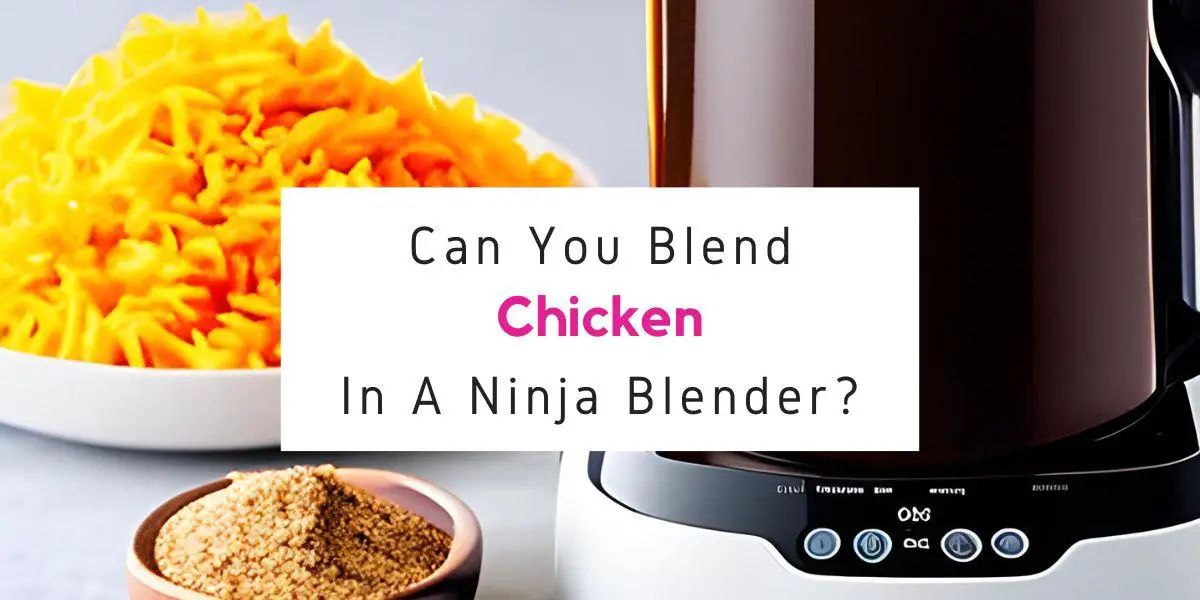Ninja Blenders are one of the most popular kitchen appliances on the market. They are known for their power and versatility. But can they blend chicken? I decided to put that question to the test and find out for myself.
In this blog post, I’ll share my results and provide some tips on how to blend chicken in a Ninja blender. Keep reading to learn more!

Can You Blend Chicken In A Ninja Blender?
The Ninja Blender is a powerful kitchen appliance that can make quick work of a variety of different ingredients. But can it handle chicken? The answer is yes, but there are a few things to keep in mind.
- First, it’s important to remove any bones or skin from the chicken before blending. This will help to prevent the chicken from getting stuck in the blades.
- Second, it’s best to cut the chicken into small pieces so that it blends evenly.
- Third, it’s important to add some liquid to the blender along with the chicken. This will help to create a smooth consistency.
- Finally, it’s important to start on a low setting and gradually increase the speed to avoid overloading the motor.
With these tips in mind, you can successfully blend chicken in a Ninja Blender.
How To Blend Chicken In A Ninja Blender
Blending chicken in a Ninja blender can be a convenient way to create dishes like chicken spreads, dips, or even baby food. Here’s a step-by-step guide on how to do it:
Ingredients and Equipment
- Cooked chicken (boiled, grilled, or roasted)
- Ninja blender (or any high-powered blender)
- Seasonings and ingredients of your choice (e.g., herbs, spices, sauces)
Steps
- Prepare the Chicken: Ensure that the chicken is properly cooked and cooled before blending. You can use leftover cooked chicken or cook fresh chicken specifically for blending. Make sure to remove any bones, skin, and excess fat.
- Cut into Smaller Pieces: Before blending, cut the chicken into smaller, manageable pieces. This will help the blender process the chicken more evenly and quickly.
- Add Seasonings (Optional): If you’d like to add flavor to the blended chicken, you can mix in seasonings, herbs, spices, or sauces at this stage. This will give your blended chicken a unique taste. Some common options include garlic, onion powder, mayonnaise, mustard, herbs like basil or cilantro, and more.
- Load the Blender: Place the cut chicken pieces (and any added seasonings) into the Ninja blender container. Make sure not to overload the blender; leave some space for the ingredients to move and blend properly.
- Start Blending: Secure the blender lid tightly. Start blending on a low setting to begin breaking down the chicken pieces. Gradually increase the speed to a higher setting as the chicken starts to blend.
- Pulse and Scrape: If necessary, stop the blender periodically to scrape down any chicken that might be sticking to the sides. This will ensure that all the chicken is evenly blended.
- Adjust Consistency: The blending time will depend on the desired consistency. For a chunkier texture, blend for a shorter period. For a smoother texture, blend for a longer time until the desired consistency is achieved.
- Check and Taste: Once you’re satisfied with the texture, stop the blender and check the blended chicken. You can taste it to make sure the flavors are balanced and adjust any seasonings if needed.
- Transfer and Store: Transfer the blended chicken to a clean container. If you’re using it immediately, incorporate it into your chosen recipe. If you’re not using it right away, store it in an airtight container in the refrigerator. Blended chicken should be consumed within a few days for freshness.
Remember that the texture and flavor of the blended chicken will vary based on the type of chicken you use, the seasonings added, and the blending time. Experiment with different combinations to find the perfect blend for your desired dish.
Can I Grind Raw Chicken In The Ninja Blender?

Yes, you can grind raw chicken in a Ninja blender, but there are a few important considerations to keep in mind to ensure safety and optimal results:
- Freshness and Quality: Use fresh and high-quality raw chicken for grinding. Make sure the chicken is properly cleaned and free from any bones, skin, and excess fat.
- Cut into Small Pieces: Before grinding, cut the raw chicken into small, manageable pieces. This will help the blender process the chicken more evenly and prevent overloading the blender.
- Chilling the Chicken: For safety reasons, it’s recommended to partially freeze the raw chicken pieces for about 20-30 minutes before grinding. This helps maintain a safe temperature and prevents bacterial growth during the blending process.
- Batch Size: Avoid overloading the blender. Process the chicken in smaller batches to ensure even grinding and to prevent straining the blender’s motor.
- Pulse and Scrape: When grinding raw chicken, use the pulse function on your blender. Pulse in short bursts, stopping to scrape down the sides as needed. This will help achieve a consistent texture and prevent the chicken from getting stuck to the sides.
- Watch for Consistency: Continue pulsing and scraping until you achieve the desired consistency. You can blend it to be fine, similar to ground meat, or leave it slightly chunky, depending on your preference.
- Safety Precautions: Raw chicken poses a risk of bacterial contamination, so ensure that you clean the blender thoroughly after use. Wash all parts that come into contact with the raw chicken with hot, soapy water to prevent cross-contamination.
- Cooking: After grinding the raw chicken, it’s best to cook it promptly to a safe internal temperature of 165°F (74°C) to eliminate any potential pathogens.
Grinding raw chicken in a Ninja blender can be convenient for creating dishes like chicken burgers, sausages, or meatballs. However, always prioritize safety and proper hygiene practices when handling raw meat to prevent foodborne illnesses.
Which Is The Best Ninja Blender For Blending Chicken?
Now that you know how to blend chicken in a Ninja Blender, you might be wondering which model is the best for this task.
There are a few things to keep in mind when choosing a Ninja Blender for blending chicken. First, you’ll want to choose a model with at least 1000 watts of power. This will ensure that the blender can handle the tough task of blending chicken.
Second, you’ll want to choose a blender with sharp blades. This will help to make quick work of the chicken and create a smooth consistency.
Third, you’ll want to choose a blender with multiple speed settings. This will allow you to start on a low setting and gradually increase the speed as needed.
With these factors in mind, the Ninja Professional Blender is a great option for blending chicken. It has 1000 watts of power, sharp blades, and multiple speed settings.
With these factors in mind, the Ninja Professional Blender is a great option for blending chicken.
Benefits Of Blending Chicken In A Ninja Blender
Blending chicken in a Ninja blender offers several benefits, making it a versatile and convenient option for creating various dishes. Here are some of the advantages:
- Consistency and Texture Control: Blending chicken allows you to control the consistency and texture of the final product. You can blend it to be as chunky or as smooth as you prefer, making it suitable for a wide range of recipes.
- Efficiency: Using a high-powered blender like a Ninja can significantly reduce the time it takes to break down cooked chicken into a desired texture. The powerful blades can quickly and effectively process the chicken, saving you time and effort compared to manual methods.
- Uniform Mixing: Blending ensures that any added seasonings, herbs, spices, or sauces are evenly distributed throughout the chicken. This leads to a consistent flavor profile in your dishes.
- Recipe Versatility: Blended chicken can be used in a variety of recipes. You can create chicken spreads for sandwiches, wraps, or crackers, blend it into dips for veggies or chips, make baby food, or even incorporate it into pasta sauces and soups.
- Waste Reduction: Blending chicken allows you to use leftover cooked chicken that might otherwise go to waste. This is especially useful if you have small amounts of chicken remaining from previous meals.
- Customization: You have complete control over the ingredients you use to flavor the blended chicken. This enables you to tailor the flavor to your preferences, dietary needs, or specific recipes.
- Texture Enhancement: Blending chicken can be particularly helpful for people who have difficulty chewing or swallowing, such as elderly individuals or those with dental issues. By blending the chicken, you create a texture that is easier to consume.
- Meal Preparation: Blending chicken in bulk can streamline meal preparation. You can prepare larger batches of blended chicken and store them in the refrigerator or freezer, ready to use whenever you need them.
- Healthy Options: When blending chicken, you have the freedom to incorporate healthier ingredients like herbs, spices, and vegetables. This can enhance the nutritional profile of the blended chicken and the dishes you create with it.
- Creative Culinary Applications: Blending chicken opens up creative possibilities in the kitchen. You can experiment with different flavors, ingredients, and combinations to create unique and delicious recipes.
- Kid-Friendly Options: Blended chicken can be used to create kid-friendly dishes like chicken nugget mixtures, spreads for sandwiches, or dips that are easier for kids to eat.
- Reduced Food Waste: By using up leftover chicken, you’re contributing to reducing food waste, which is an important aspect of sustainable cooking.
Overall, blending chicken in a Ninja blender provides you with a convenient way to transform cooked chicken into various forms that suit your culinary needs. It’s a technique that can save time, enhance flavors, and offer a wide array of options for your meals.
Recipes That Can Be Made With Blended Chicken

Blended chicken opens up a world of culinary possibilities. Here are some recipes that you can make using blended chicken:
- Chicken Salad
- Combine blended chicken with mayonnaise, chopped celery, diced apples, and toasted nuts.
- Season with salt, pepper, and a touch of lemon juice.
- Serve on sandwiches, wraps, or a bed of greens.
- Chicken Dip
- Blend chicken with cream cheese, shredded cheese, and your favorite seasonings (like garlic powder, onion powder, and paprika).
- Bake until bubbly and serve with crackers, tortilla chips, or vegetable sticks.
- Chicken Spread
- Blend chicken with Greek yogurt, Dijon mustard, chopped fresh herbs, and minced garlic.
- Spread on whole-grain bread or crackers for a healthy snack.
- Chicken Quesadillas
- Mix blended chicken with shredded cheese and diced vegetables.
- Spread the mixture on tortillas, fold them in half, and cook until the cheese is melted and the tortillas are crispy.
- Chicken Pasta Sauce
- Blend chicken with cooked pasta, a creamy sauce (such as Alfredo or tomato cream), and sautéed vegetables.
- Heat the mixture until warmed through and serve as a hearty pasta dish.
- Chicken Soup Base
- Blend chicken with broth, cooked vegetables, and herbs.
- Heat the mixture for a quick and easy chicken soup base.
- Chicken Baby Food
- Blend chicken with cooked vegetables like carrots, sweet potatoes, and peas.
- Add a bit of water or broth to achieve the desired consistency for baby food.
- Chicken Tacos or Burritos
- Blend chicken with black beans, corn, and a blend of spices.
- Use the mixture as a filling for tacos, burritos, or enchiladas.
- Chicken Nuggets or Patties
- Blend chicken with breadcrumbs, an egg, and seasonings.
- Form into nuggets or patties, then bake or pan-fry until golden brown.
- Chicken Pizza Topping
- Spread blended chicken on pizza crust, add tomato sauce, cheese, and your favorite toppings.
- Bake until the cheese is melted and bubbly.
- Chicken Stuffed Peppers
- Blend chicken with cooked rice, diced vegetables, and tomato sauce.
- Stuff the mixture into bell peppers, top with cheese, and bake until the peppers are tender.
- Chicken and Veggie Wraps
- Spread blended chicken on tortillas, then add a layer of hummus and fresh vegetables like lettuce, cucumber, and tomato.
- Roll up the tortillas for a nutritious wrap.
Remember, these recipes are just starting points. You can customize the ingredients, seasonings, and ratios to suit your taste preferences and dietary needs. Blended chicken provides a versatile base that can be adapted to a wide range of cuisines and dishes.
Are There Other Ways To Shred Chicken?

Absolutely, there are several other methods you can use to shred chicken if you don’t have a blender or if you’re looking for alternative techniques. Here are a few options:
- Hand Shredding: This is the most straightforward method. After cooking the chicken, allow it to cool slightly, then use your hands to pull the meat apart. You can shred it as finely or as chunky as you like.
- Fork Shredding: Similar to hand shredding, you can use two forks to pull the chicken apart. Hold one fork in each hand and gently pull the meat in opposite directions.
- Mixing Bowls and Hand Mixer: Place the cooked chicken in a large mixing bowl. Use a hand mixer on low speed to break down the chicken into smaller pieces. Be careful not to over-mix, as this can turn the chicken into a paste.
- Stand Mixer: If you have a stand mixer, you can use the paddle attachment to shred cooked chicken. Place the chicken in the mixer bowl and use the paddle attachment on low speed to break it apart.
- Food Processor: Similar to a blender, a food processor can be used to pulse cooked chicken into smaller pieces. Be sure not to over-process, as you want to achieve a shredded texture rather than a paste.
- Stand Mixer with Paddle Attachment: If you have a stand mixer, you can use the paddle attachment to shred cooked chicken. Place the chicken in the mixer bowl and use the paddle attachment on low speed to break it apart.
- Mashing with Kitchen Tools: You can use kitchen tools like a potato masher or a pastry cutter to press and mash the cooked chicken until it’s shredded to your desired consistency.
- Kitchen Shears: Kitchen shears or scissors can be used to cut the cooked chicken into small pieces. This method might not give you fine shreds, but it can work well for dishes like salads and wraps.
- Graters: A box grater with larger holes can be used to grate cooked chicken into smaller pieces. This method can result in a more textured shred.
- Manual Meat Shredders: There are specialized manual tools designed specifically for shredding meat. These typically consist of sharp claws that you can use to tear the meat apart.
Each of these methods has its own advantages and considerations. Choose the one that best fits your equipment and preferences, and be mindful of safety and hygiene while handling cooked chicken.
The Verdict – Is The Ninja Blender Good For Blending Chicken?
The good news is that the Ninja is more than up to the challenge of blending chicken; in fact, it can produce smooth, evenly textured results in just seconds. In addition to being quick and efficient, the Ninja is also very easy to use; simply add your chicken and desired sauce or seasonings to the blender and let it do its work.
Whether you’re looking to create a healthy chicken soup or make your own baby food, the Ninja blender is a great choice.



